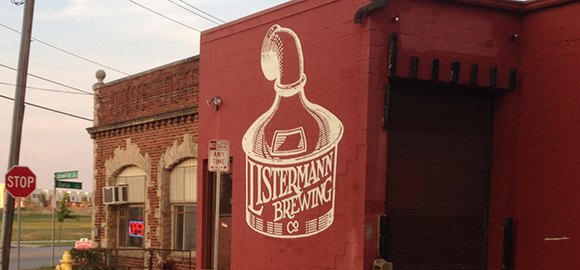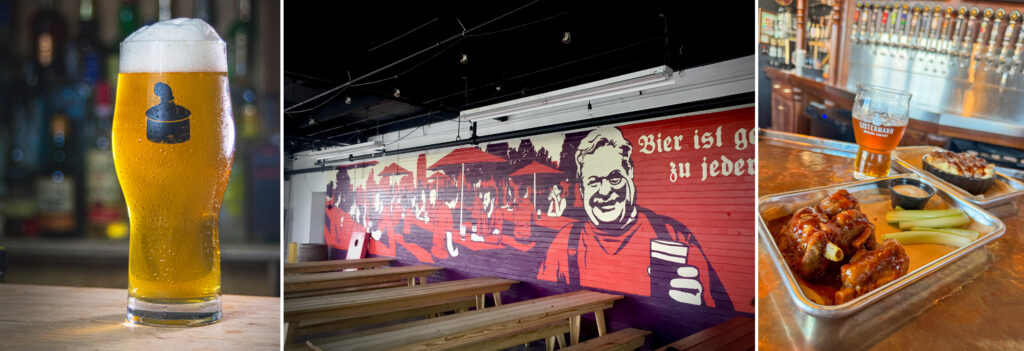Listermann Brewing Company Is Closed.
Written By: The Gnarly Gnome
Photography By: The Gnarly Gnome
8/17/25

I didn’t want to admit it to myself, but not so deep down, I knew that this was a possibility. Listermann Brewing Company is officially closed, and pretending it comes as a shock to me would be very disingenuous. The industry is currently in a challenging position, as it recovers from a period of intense growth, and adjusts to what that means for today. Keeping any brewery running through this is difficult, let alone one going through as many changes as Listermann has been.
Hang on tight; I have a few thoughts to share about this one.
Who, Or What IS Listermann
Throughout history, many different personalities have contributed to making Listermann Brewing Company a place that many of us have called ‘home’ at one time or another. For some of us, it all started with Dan Listermann. Back in the early 90s, Dan began manufacturing homebrewing equipment before finding a permanent home on Dana Ave for his manufacturing business. This space grew into a full-scale homebrew shop, a massive (by today’s homebrew shop standards) place where homebrewers didn’t just come and buy their ingredients; they came to talk about beer.
I was never a great homebrewer, and I never fully committed to the hobby the way some people do. Listermann, though? This was the place that you’d spend an afternoon and feel the courage to explore. There’s something magical about the process of making beer, but the folks at Listermann made it feel accessible and fun, even for someone like me who isn’t particularly skilled at it. Without the Listermann homebrew shop, my journey through craft beer would look a lot different from what it does now. The limited amount of homebrewing I did, along with the conversations that resulted from it (and the actual process of making the beer), shaped my knowledge of the beverage.
In 2008, before a taproom was easily accessible here in Ohio, Listermann managed to secure a brewing license and a two-barrel brewhouse to produce their beer. These 22oz bombers were sold out of the homebrew shop… and Listermann Brewing Company was born. It wasn’t the best Listermann beer to get in my beer glass, but at a time when Cincinnati only had a handful of actual, real, local breweries, it was game-changing for a drinker like me. The next ten years, or so, were a blur. One piece after another, the Listermann that we all know today came together.
Thanks to folks like Kevin Moreland (now of Fretboard), Jason Brewer (now of Wandering Monsters), Jared Lewinsky, and Chris Mitchell, heck… to a whole list of people like Chuck, Jon, Patrick, Pat, Abby, Matthew, Allen, Johnny, Kristen, JP, Josh, Karenna, … they all (plus more people over the years that I KNOW I’m missing) Listermann developed a soul that was never about one person, or one personality. It became a unique piece of Cincinnati beer that can’t be, and never will be replicated.

What Happened?
I’m not privy to the inner workings of anyone’s business, so my opinions on what happened to a company like this are just that – my opinions. The easy answer is that it’s a complicated time for beer, and with that, the closure of an institution like Listermann is just that… complicated.
It wasn’t the “fault” of new ownership. Nor was it caused by employees moving on to different projects, or a lack of stouts, or not enough NE IPAs. It’s not the apathy of students at Xavier, or the food options in the taproom. As much as you can’t lay the success of what Listermann was at its peak on one person or one aspect, neither can you its eventual failure.
Each of us could point out something that we would have changed, which surely would have solved things. I’m sure if you are hanging out with your drinking buddies over the next few weeks, talking about Listermann, you’ll do just that. The truth is, a little bit of all of it contributes to this closure.
The Bigger Failure Around Us
Craft beer today is very different from what craft beer looked like in 2008 or even 2018. Craft breweries are now more than just small taprooms where people come to have a pint of beer; perhaps that’s the natural progression of this industry was always going to move towards. There are massive taprooms that feel like restaurants, and combo distillery/brewery buildings that serve steak at tables with white tablecloths, sit next to places with multi-story patios and huge pizza ovens. Instead of being founded by some geeky homebrewer in an industrial park, companies are founded by retired Fortune 500 retirees and groups of investors.
Things are different… through what might have been the natural progression of things all along.
I don’t think that every place is meant to change in that same way. I also think that when you look at a brand (like Listermann in this case), a place that was built not by a head brewer, a founder, or a marketing team – a place that was built by a community of homebrewers, beer geeks, and folks who just wanted to belly up and have a conversation, it’s hard to grow it in the same way that other “modern” breweries grow.

Where I Think It Went Wrong
I’ve been staring at a Listermann Brewing Company timeline (I keep these in my notes for all our local breweries) and trying to pinpoint the exact point that I think Listermann “went wrong” with things.
They started expanding heavily back in late 2014. They’d experience a ton of success at Great American Beer Fest, and were eager to capitalize on that success. They put in a patio out front. In 2015, they doubled their capacity, won a huge medal for Chickow! at FoBab. They added their Fermentorium, started making wine, mead, and all sorts of other drinks. I still think Listermann was firing on all cylinders at this point.
In 2016, they added a kitchen via Renegade Street Eats… people like food with their beer. Was this it? No… that’s not it.
It could be that it was 2017 when the first Team Fiona NE IPA was released, and the line stretched around the block, even full of people who’d never drank a beer in their life before. Nah… that was awesome.
For me… 2021 was the first sign of trouble. Post-COVID, things in the industry got weird, and Listermann opened up the Listermann Trail House. This soulless pizza restaurant down the street from the brewery was the first sign to me that Listermann was headed in the wrong direction. (I’m sorry to the folks from Listermann who will read this…) The taproom only lasted a year, and that was for very good reasons. Wrong spot, wrong personality, and the very wrong direction for Listermann Brewing Company.
The year after the closure of the Trail House, founders Dan and Sue Listermann sold the business to Steve and Terrie Ipson… but I think the writing was already on the wall.
Listermann itself didn’t want to be what the industry was telling everyone that it was ‘supposed’ to be, and that’s why today… It’s closed.
Be Gnarly, Support The Places You Love.

The craft brewery scene in Cincy has been over-saturated for a long time. There was going to be a re-balance even w/o other market influences. But, those influences have been building nonetheless. The trend away from alcoholic beverages, inflation jacking up everything, people fleeing the food service industry, taxes, insurance . . . . etc. etc. etc . . . Doesn’t really matter which business is the oldest if the “float” catches up to them at an inopportune time. There’s some out there who borrowed money to stay afloat during/after covid. That can go horribly wrong. Profits have to exceed expenses and not everyone can time the pivot.
These days we’re having lunch in near vacant chili parlors. No long waits at our favorite restaurants either. There’s much less discretionary spending going on at our house. It’s easy to figure we’re not unusual in that. It’s much cheaper to drink at home, too.
I agree. I also think restaurants have been hit a lot harder than breweries. There are a TON of reasons for the closures we’ve seen, and I think it’s easier for people to just want to point at ONE thing.
To maybe illustrate my feelings: I love Rhinegeist… but they’re making half of the beer being brewed in this city right now. (Obviously not counting Sam Adams or Miller) – the term oversaturation is where I keep getting hung up. All breweries aren’t the same thing – a place even like Sonder makes ten times as much beer as a Dead Low or a Brink, a Narrow Path or a Wandering Monsters. We’re not saturated in breweries, but might be in production numbers right now.
I don’t advocate for anyone to close, but I do advocate for the best beer to exist, and for more smaller places over larger places – if that makes sense… but a lot of current breweries were founded and funded in ways that aren’t going to allow that without some very wild changes.
I feel bad about this. I don’t ever wish failure on anyone. I’m a homebrewer. I went to Listermanns for supplies. The new owners neglected the homebrew store. I took my business elsewhere because I was tired of going to Listermanns and not finding basic things I wanted. I get that homebrewing is falling off, just look at what the American Homebrewers Association is saying. But I think the new owners forgot what the homebrewers brought to the table. I never just bought homebrew supplies. I bought pints at the taproom and cans. I visited Listermanns as much as any brewery because the homebrew store bought me there. Homebrewers also recommend breweries to others. The new owners lost that goodwill.
There are 5 breweries within 10 minutes of my house. Probably a dozen within 20 minutes. I’m not going to drive 45 minutes away without a reason. The homebrew store was the reason. Then it wasn’t.
I still think there’s something that we’re not being told. Who closes a business after two decades by posting “tomorrow is our last day” on Facebook at 7pm on a Friday?
It wasn’t the original ownership that closed, Dan and Sue Listermann retired and sold the business about two years ago. The new owners are the ones that shut it down with one day notice, on the same day as Beer and Sweat, a massive homebrew competition.